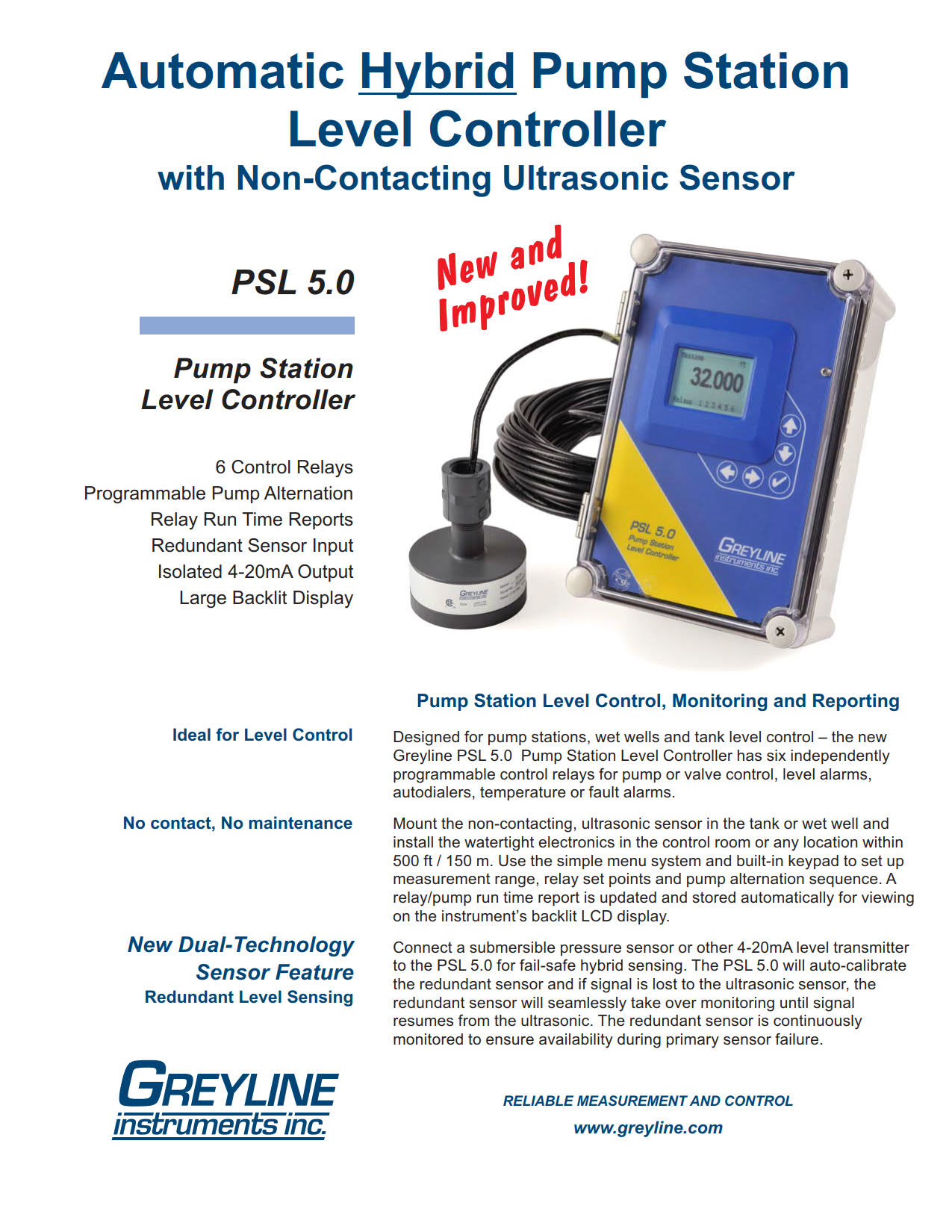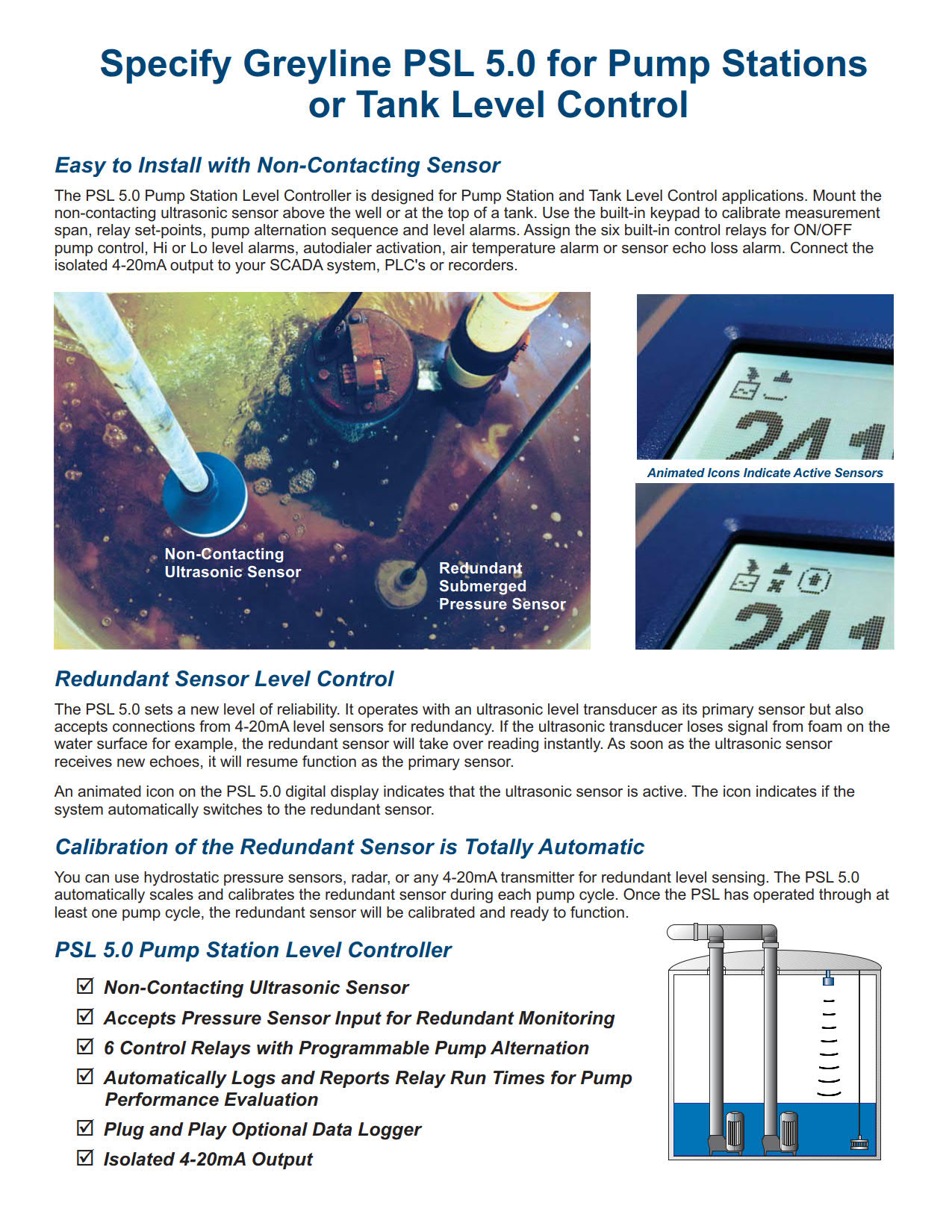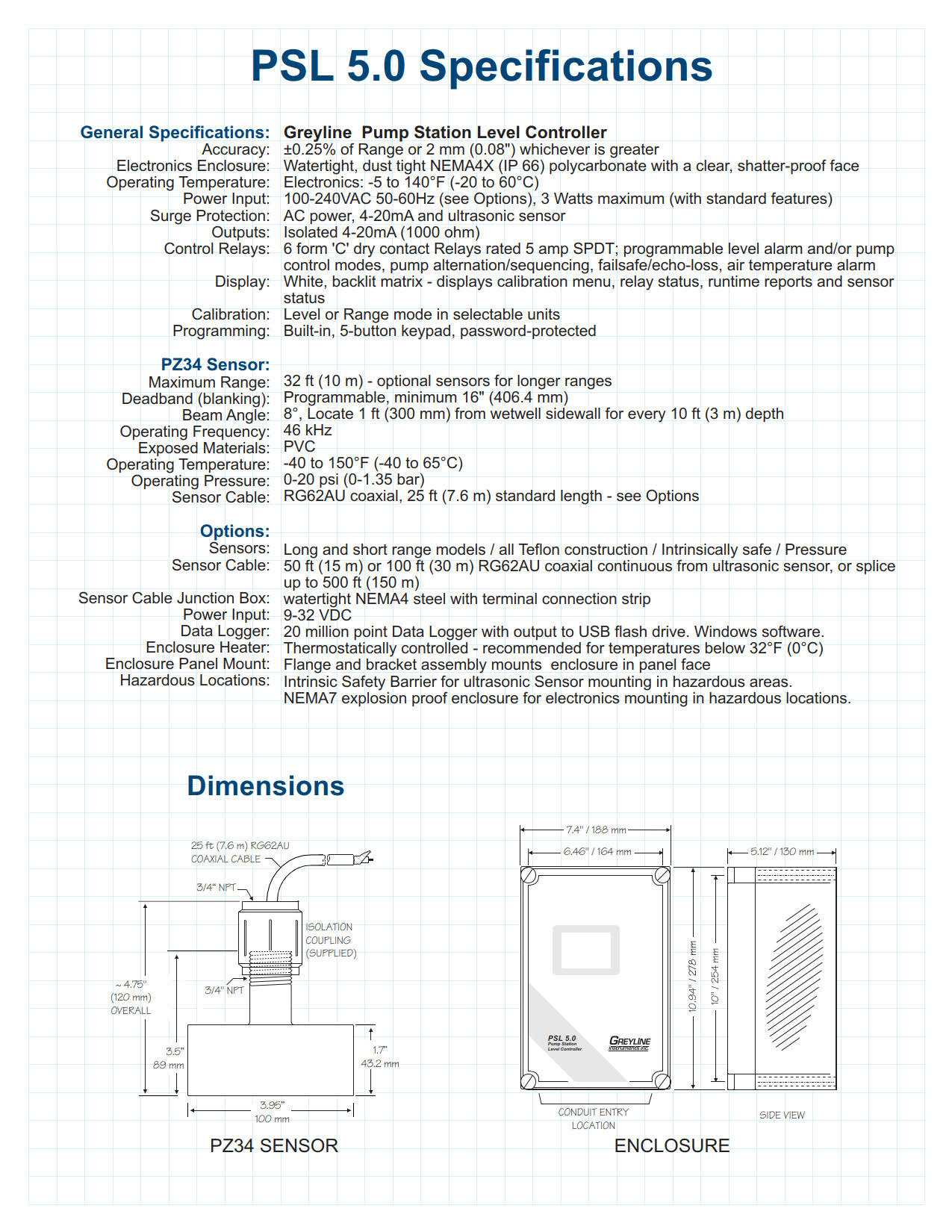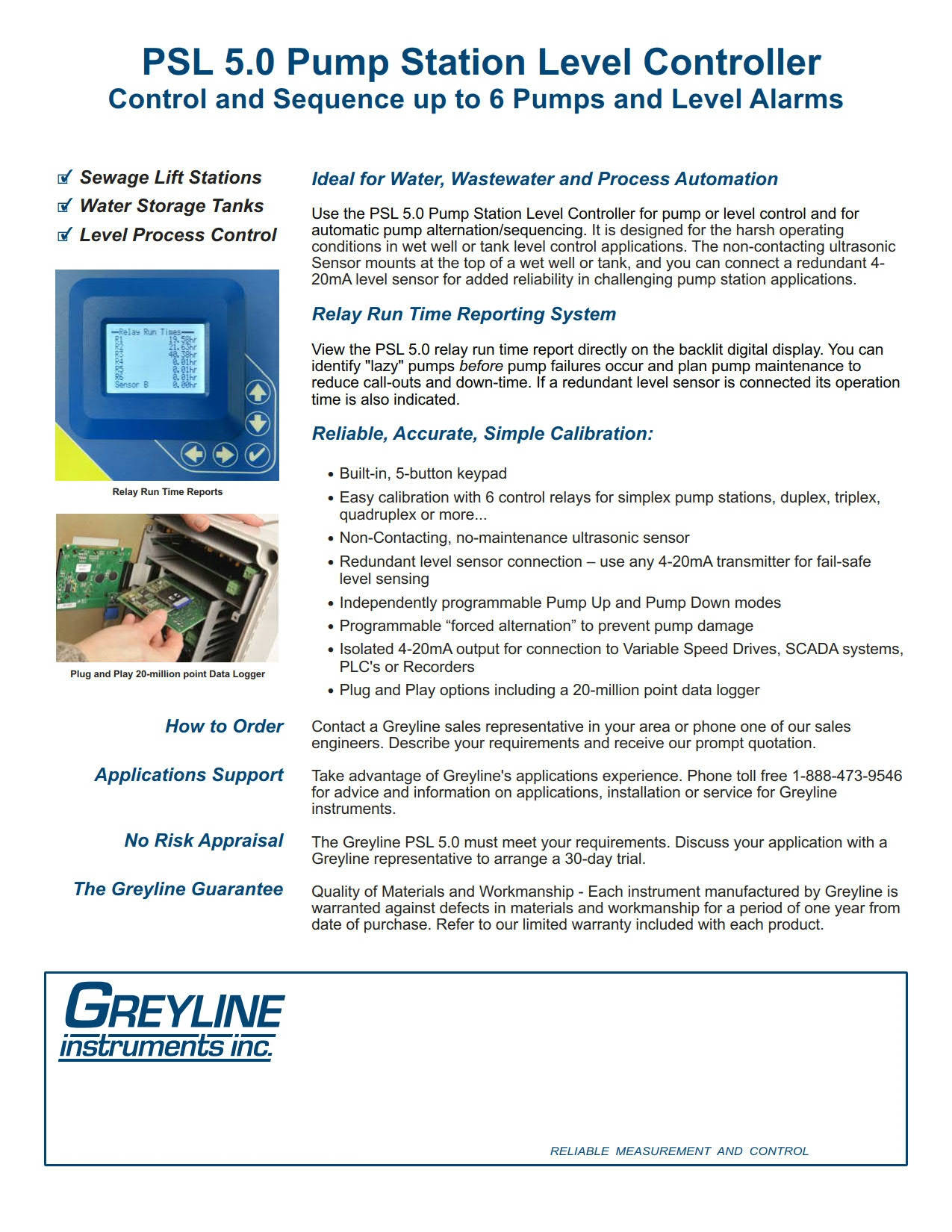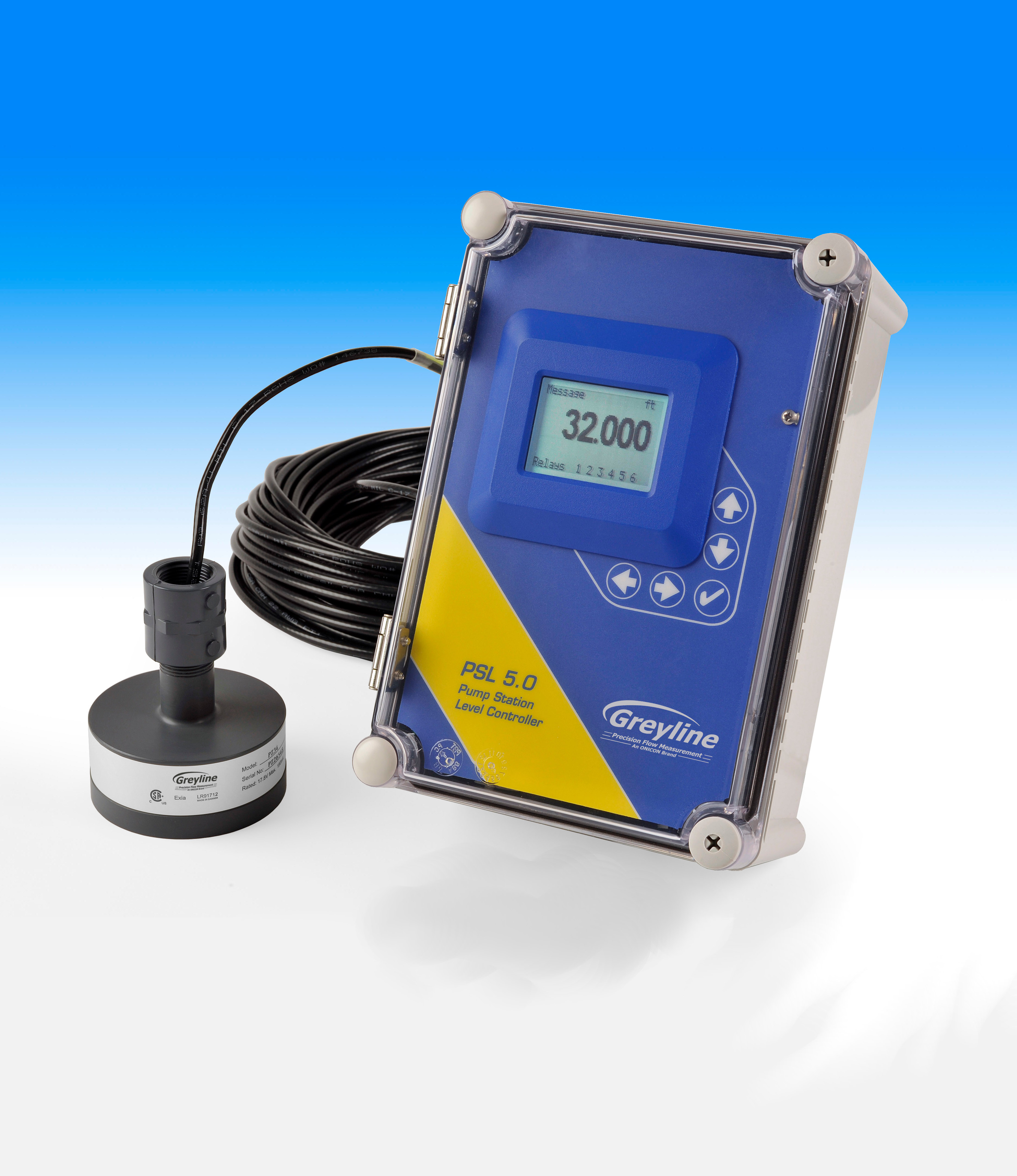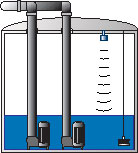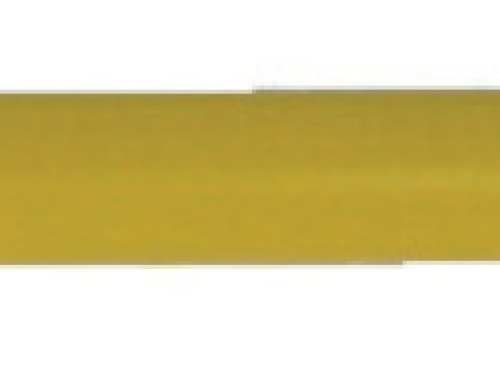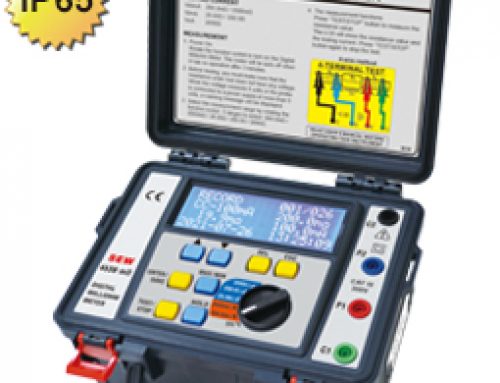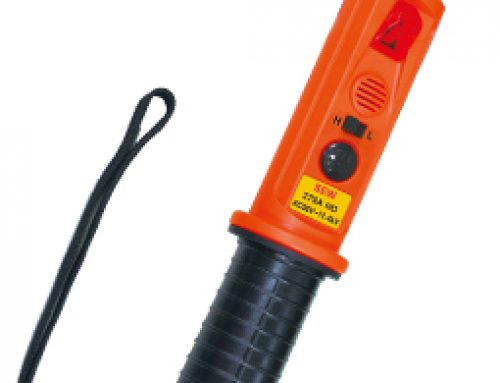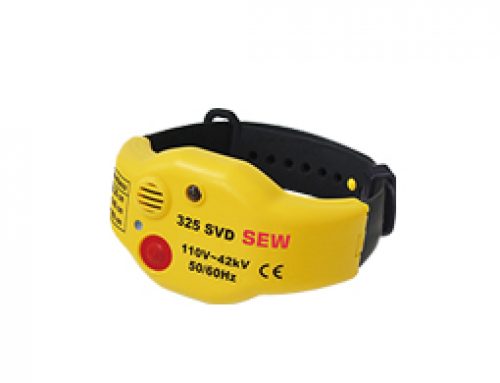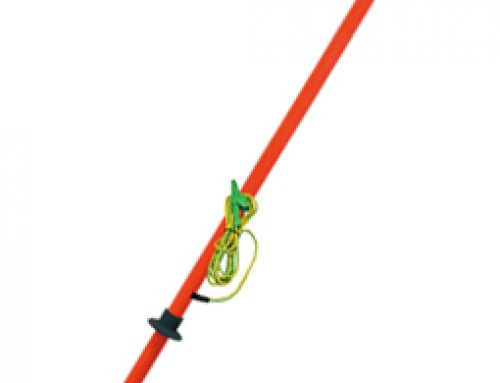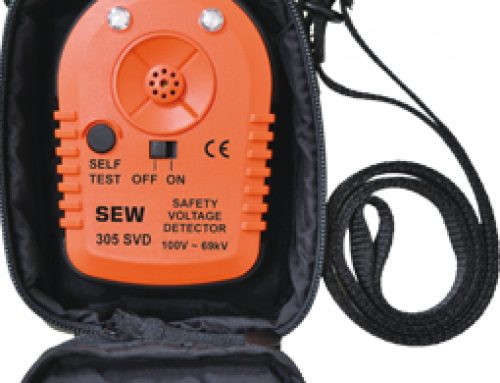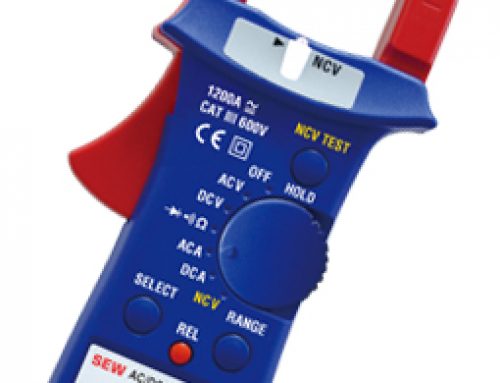PSL 5.0混合泵站液位控制器
- 控制,传输和显示
- 非接触式超声波传感器
- 新的双技术特性 – 冗余电平传感器输入
- 6个泵控制,泵轮换和液位报警继电器
- 隔离4-20mA输出
- 内置5键校准器
- 记录和显示中继运行时间
PSL 5.0 Hybrid Pump Station Level Controller
- Controls, Transmits and Displays
- Non-Contacting Ultrasonic Sensor
- New Dual-Technology Feature- Redundant Level Sensor Input
- 6 Relays for Pump Control, Pump Alternation and Level Alarms
- Isolated 4-20mA output
- Built-in 5-Key Calibrator
- Logs and Displays Relay Run Times
新的泵和升降站液位控制器
适用于污水泵站,升降站,湿井和水箱液位控制,非接触式超声波传感器安装在液体上方。新型Greyline PSL 5.0液位控制器具有6个可独立编程的控制继电器,用于泵或阀门控制,液位报警,拨号器,温度报警和回波损耗报警。
将非接触式超声波传感器安装在水箱或湿井中,并将防水电子装置安装在控制室或500英尺/ 150米范围内的位置。使用简单菜单系统和内置键盘设置测量范围,继电器设定点和泵交替顺序。继电器/泵运行时间报告会自动更新并自动存储,以便在PSL 5.0背光LCD显示屏上查看。
对于危险场所,超声波传感器的额定本质安全,带有可选的安全栅。它的额定测量范围可达32英尺/ 10米,或使用额定50英尺/15.6米测量范围的可选PVC传感器。
用于冗余级别监控的新型双技术传感器功能
将潜水压力传感器或其他4-20mA液位变送器连接到PSL 5.0,以实现故障安全混合感应。PSL 5.0将自动校准冗余传感器,如果超声波传感器丢失信号,冗余传感器将无缝接管监控,直到信号从超声波恢复。持续监控冗余传感器,以确保主传感器故障期间的可用性。
混合PSL 5.0解决了回声丢失标注问题
埃克维尔艾伯塔镇的污水提升站受到超声波液位控制器的标注警报的困扰,因为泡沫和油脂覆盖水面并导致回波损失。操作员安装了新的Greyline PSL 5.0泵站液位控制器和冗余传感器来解决问题。
New Pump and Lift Station Level Controller
Ideal for sewage pump stations, lift stations, wet wells and tank level control with a non-contacting ultrasonic sensor mounted above the liquid. The new Greyline PSL 5.0 Level Controller has 6 independently programmable control relays for pump or valve control, level alarms, dialers, temperature alarm and echo-loss alarm.
Mount the non-contacting, ultrasonic sensor in the tank or wet well and install the watertight electronics in the control room or any location within 500 ft / 150 m. Use the simple menu system and built-in keypad to set up measurement range, relay set points and pump alternation sequence. A relay/pump run time report is updated and stored automatically for viewing on the PSL 5.0 backlit LCD display.
For hazardous locations, the ultrasonic sensor is rated Intrinsically Safe with an optional safety barrier. It is rated for measurement ranges up to 32 ft / 10 m, or use the optional PVC Sensor rated for 50 ft / 15.6 m measurement range.
New Dual-Technology Sensor Feature for Redundant Level Monitoring
Connect a submersible pressure sensor or other 4-20mA level transmitter to the PSL 5.0 for fail-safe hybrid sensing. The PSL 5.0 will auto-calibrate the redundant sensor and if signal is lost to the ultrasonic sensor, the redundant sensor will seamlessly take over monitoring until signal resumes from the ultrasonic. The redundant sensor is continuously monitored to ensure availability during primary sensor failure.
Hybrid PSL 5.0 Solves Echo Loss Callouts
Sewage lift stations at the Town of Eckville Alberta were plagued by callout alarms from ultrasonic level controllers as foam and grease covered the water surface and caused echo loss. Operators installed new Greyline PSL 5.0 Pump Station Level Controllers with redundant sensors to solve the problem.
泵站液位控制器规范
范围:本规范涵盖由Greyline Instruments,Largo,Florida/Long Sault,Ontario制造的非接触式超声波泵站液位控制器。
该仪器应能显示、传输湿井或油罐液位,并控制多达六台泵或报警器。
A.通用
泵站液位控制器由非接触式超声波传感器、连接电缆和带有指示、传输和控制电子设备的远程外壳组成。
测量精度应为量程的±0.25%或2 mm(0.08”),以较大者为准,并应自动进行温度补偿。
传感器电缆长度应符合安装要求,不得超过500’(152 m)。
系统应无活动部件,且不得接触被测材料。
应包括内置键盘和简单的校准菜单系统。
应包括一个非接触式超声波液位传感器和混合传感器功能,用于双技术冗余液位传感,输入来自4-20mA液位传感器。
B.传感器/变送器
非接触式超声波传感器应采用PVC制成。
传感器的最小死区或空白区应为16”(407 m m),最大范围为32 ft.(10 m),工作频率为46 kHz,超声波束角为8度。
传感器应能承受20 psi的意外淹没。
传感器工作温度应为-40°F至150°F(-40°C至65°C)。
传感器应包括整体式温度传感器。
不接受需要单独安装和布线的温度传感器。
传感器电缆应安装在塑料或接地金属导管中。
C.传感器连接电缆
提供连续长度为25英尺(7.6米)的RG62AU同轴电缆,并在传感器头上进行防水封装连接。
延伸传感器电缆应为RG62AU同轴电缆,最大500’(152m)。
电缆应采用制造商推荐的接线盒中的螺纹终端连接进行拼接。
水平和温度信号应在一根同轴电缆上进行。不接受单独或多芯电缆。
传感器电缆应安装在接地金属导管中。
D.发射机
泵站液位控制器应接受来自外部液位变送器的4-20mA输入,以实现冗余。
冗余传感器应通过泵站液位控制器的超声波传感器连续自动校准。
发送器应提供范围或级别模式下的密码保护校准和用户选择的工程单位。
现场校准应允许选择和自动转换测量单位、测量范围和控制继电器。
不接受通过参数代码、BCD开关或外部校准器进行校准的系统。
变送器电源输入应为100-240VAC 50/60Hz,要求小于3瓦特。
校准数据和仪器设置应通过断电存储至少12个月。
发射机应允许现场可编程阻尼在湍流水平条件下平滑输出,并允许可编程抑制时间忽略来自湍流、波浪和虚假回波的虚假信号。
变送器工作温度应为-5°至140°F(-20°至60°C)。
变送器应具有隔离的4-20mA输出,最大负载为1000 ohm。
提供6个“C”型干触点控制继电器,额定电流为5安培SPDT。
继电器应可单独编程,用于高或低液位报警、双设定点泵控制、泵切换、传感器温度报警和回波损失报警。
继电器应允许用户调整延时设置,以防止泵或电机功率波动。
继电器可单独配置为在回波丢失情况下保持状态、通电或断电。
提供一个白色背光LCD显示屏,指示用户选择的工程单位中的液位和继电器状态。
在不打开仪表盖的情况下,应能看到发射器显示的指示水平、校准单位和继电器状态。
仪表应包括继电器运行时间报告系统和背光LCD显示屏上的泵显示小时数、警报和故障保护传感器操作。
变送器应安装在壁装式防水NEMA4X(IP 66)聚碳酸酯外壳内,带铰链式透明盖。
应包括安装硬件。
应在交流电源输入、传感器和4-20mA输出端对变送器电子设备进行浪涌保护。
变送器应允许插入式现场安装和自动检测可选附件,包括数据记录器。
E.根据需要插入的可选功能
传感器、连接电缆和接线盒的本质安全等级应为I、II、III级,I、II类,C、D、E、F、G组。
有一个恒温控制的外壳加热器,用于温度低于冰点时的变送器操作。
当通过经批准的安全栅连接时,应具有PZ32TE型全特氟隆传感器,其额定本安性为-40°F至170°F(-40°C至76°C)。
有一个pvc和特氟隆传感器型号pz56,适用于高达50英尺(15.6米)的液体测量范围。
具有一个聚四氟乙烯面法兰安装传感器型号PZ34TXF,额定测量范围为32英尺(10米)。指定法兰尺寸为4“或6”。
有一个冗余的潜水压力传感器,电缆长度为40英尺(12米),额定水深为35英尺(10米)。
使用制造商推荐的外壳防晒霜,以便在阳光直射下安装变送器。
使用制造商推荐的传感器防晒霜,以便在阳光直射下安装温度补偿传感器。
为外壳安装提供制造商推荐的面板安装法兰组件。
内置200万点数据记录器,USB输出到闪存驱动器或大容量存储设备。
包括Windows软件。
电源输入为9-32Vdc,功耗小于3.5瓦。
G.制造商
泵站液位控制器应为Greyline Instruments Inc.制造的PSL 5.0型,并应保证一年内不会出现材料和工艺缺陷。
规格如有更改,恕不另行通知。如果您在申请中需要更多信息或建议,请联系Greyline。我们可以提供报价,并向贵公司所在地区的Greyline销售代表咨询。
PUMP STATION LEVEL CONTROLLER SPECIFICATIONS
SCOPE: This specification covers a non-contacting ultrasonic Pump Station Level Controller as manufactured by Greyline Instruments, Largo, Florida / Long Sault, Ontario. This instrument shall provide for indicating, transmitting of wet well or tank level, and control of up to six pumps or alarms.
A. GENERAL
Pump Station Level Controller to consist of an non-contacting ultrasonic sensor, connecting cable, and a remote enclosure with indicating, transmitting and controlling electronics.
Measurement accuracy shall be ±0.25% of Range or 2 mm (0.08″), whichever is greater, and shall be automatically temperature compensated.
Sensor cable length shall be as required by installation, not to exceed 500′ (152 m).
System shall have no moving parts and shall not contact the material being measured.
Shall include a built-in keypad and simple menu system for calibration.
Shall include a non-contacting ultrasonic level sensor plus hybrid sensor function for dual-technology redundant level sensing with input from a 4-20mA level transmitter.
B. TRANSDUCER/SENSOR
Non-contacting ultrasonic sensor shall be constructed of PVC.
The sensor shall have a minimum deadband or blanking of 16″ (407 mm) and a maximum range of 32 ft. (10 m), and have an operating frequency of 46 kHz with an ultrasonic beam angle of 8 Degrees.
Sensor shall withstand accidental submersion to 20 psi.
Sensor operating temperature shall be from -40°F to 150°F (-40°C to 65°C).
Sensor shall include integral temperature sensor. Temperature sensors requiring separate mounting and wire runs shall not be accepted.
Sensor cable shall be installed in plastic or grounded metal conduit.
C. SENSOR CONNECTING CABLE
Provide RG62AU coaxial cable 25′ (7.6m) continuous length, with waterproof, potted bond to the Sensor head.
Extended sensor cable shall be RG62AU coaxial to a maximum of 500′ (152m). Cable shall be spliced with screw terminal connections in manufacturer’s recommended Junction Box.
Level and temperature signals shall be conducted on one single coaxial cable. Separate or multiple-conductor cables shall not be accepted.
Sensor cable shall be installed in grounded metal conduit.
D. TRANSMITTER
The Pump Station Level Controller shall accept 4-20mA input from an external level transmitter for redundancy. The redundant sensor shall be continuously auto-calibrated by the Pump Station Level Controller’s ultrasonic sensor.
The transmitter shall provide for password-protected calibration in Range or Level modes and user-selected engineering units. Field calibration shall allow selection and automatic conversion of measurement units, measurement span and control relays. Systems requiring calibration by Parameter codes, BCD switches or external calibrators shall not be accepted.
The transmitter power input shall be 100-240VAC 50/60Hz requiring less than 3 Watts.
Calibration data and instrument settings shall be stored through power interruptions for a minimum of 12 months.
Transmitter shall permit field programmable damping to smooth output in turbulent level conditions, and programmable rejection time to disregard false signals from turbulence, waves and spurious echoes.
Transmitter operating temperature shall be from -5° to 140°F (-20° to 60°C).
Transmitter shall have an isolated 4-20mA output into a 1000 ohm maximum load.
Provide 6 Form ‘C’ dry contact control relays rated 5 ampere SPDT. Relays shall be individually programmable for High or Low level alarms, dual set point pump control, pump alternation, sensor temperature alarm and echo loss alarm. Relays shall permit user-adjustable On time delay settings to prevent pump or motor power surges. Relays may be individually configured to hold state, energize or de-energize in the event of an echo-loss condition.
Provide a white, backlit LCD display indicating level and relay states in user-selected engineering units.
Transmitter display indicating level, units of calibration and relay states, shall be visible without opening the instrument cover.
The instrument shall include a relay run time reporting system and display hours of pump, alarm and failsafe sensor operation on the backlit LCD display.
Transmitter shall be housed in a wall-mount, watertight NEMA4X (IP 66) polycarbonate enclosure with hinged, clear cover. Mounting hardware shall be included.
Transmitter electronics shall be surge protected on AC power input, sensor and 4-20mA outputs.
The transmitter shall permit plug-in field installation and auto-detection of optional accessories including data logger.
E. OPTIONAL FEATURES FOR INSERTION AS REQUIRED
Sensor, connecting cable and junction boxes shall be rated intrinsically safe to Class I,II,III, Div. I,II, Groups C,D,E,F,G.
Have a thermostat controlled enclosure heater for Transmitter operation at temperatures below freezing.
Have an all-Teflon sensor Model PZ32TE rated intrinsically safe when connected through an approved safety barrier, and rated for operation from -40°F to 170°F (-40°C to 76°C).
Have a PVC and Teflon sensor Model PZ56 rated for measurement range on liquids up to 50 ft. (15.6 m).
Have a Teflon-faced flange mount sensor model PZ34TxF rated for 32 ft (10 m) measurement range. Specify flange size of 4” or 6”.
Have a redundant submersible pressure transducer with 40 ft (12 m) cable rated for 35 ft (10 m) water depth.
Have manufacturer’s recommended enclosure sunscreen to permit Transmitter mounting in direct sunlight.
Have manufacturer’s recommended Sensor sunscreen to permit temperature-compensated Sensor mounting in direct sunlight.
Have manufacturer’s recommended Panel Mount Flange assembly for enclosure installation.
Have a built-in 2 million point Data Logger with USB output to flash drive or mass storage device. Include Windows software.
Have power input of 9-32VDC and power consumption of less than 3.5 Watts.
G. MANUFACTURER
Pump Station Level Controller shall be model PSL 5.0 as manufactured by Greyline Instruments Inc. and shall be warranted against defects in materials and workmanship for one year.
Specifications are subject to change without notice. Please contact Greyline if you need more information or for advice in your application. We can provide quotations and refer you to the Greyline sales representative in your area.
流量计运作原理
仪器电子设备测量从发送声音到回声返回所需的时间。根据空气中的声速,可以高精度计算出液体表面与传感器的准确距离(0.25%范围)。
由于声速受空气温度的影响,灰线超声波液位传感器包括一个内置的温度传感器。水平/距离测量在传感器的整个工作温度范围内自动进行温度补偿。
传感器的位置应使其能清楚地“看到”液体表面,远离梯子、管道或其他障碍物。Greyline建议每10英尺深度距离侧壁1英尺(每3米深度300毫米)。来自搅拌器的假回波(在传感器下扫过)、湍流和波可以被仪器过滤和忽略。
Greyline模型的范围从简单的4-20mA液位指示发送器,到复杂的监控、控制和数据记录模型。返回greyline产品了解级别模型详细信息和规格。有关包括超声波在内的各种液位仪表技术的信息,请参阅废水液位测量技术。
测量管外脏污或充气液体的流量
多普勒效应由奥地利物理学家克里斯蒂安·多普勒于1842年提出。我们每天都能听到多普勒的例子:火车经过时的汽笛声改变音调,或者赛车驶过我们的位置时的排气噪音。
多普勒技术只适用于含有固体或气泡的液体来反射其信号。这些是“困难”的液体,可能会损坏常规流量计:泥浆、污泥、废水、磨料、粘性和腐蚀性化学品。由于传感器安装在管道外部,因此没有压降,也没有流动障碍物。
为了获得很好性能,多普勒传感器应安装在远离湍流产生装置(如弯管和三通)的地方,远离速度增加装置(如控制阀和泵)。典型精度为满刻度的±2%。多普勒仪器包括一个夹式超声波传感器、连接电缆和一个电子外壳,可以安装在附近方便的位置(500英尺/152米范围内)。传感器可以本质安全地额定安装在危险的额定位置。
需要非常精确的定时电路,但当传感器可以安装在流量均匀分布的管段上时,1%的精度非常典型。
由于超声波信号必须穿过管道到达接收传感器,因此流体中不得含有大量气泡或固体(小于2%)。否则高频声音会减弱,太弱,无法穿过管道。应用包括饮用水、冷却水、水/乙二醇溶液、液压油、燃油和化学品。
渡越时间传感器通常工作在1-2兆赫的频率。高频设计通常用于较小的管道,低频设计用于直径达数米的大型管道。
水槽和堰是专门设计的渠道形状,以表征水流。常见的类型有矩形堰、V型槽堰、Parshall水槽和Palmer Bowlus水槽。水槽或堰型的选择取决于应用:流速、渠道形状和水的固体含量。请联系Greyline Instruments以获取有关为您的应用选择合适水槽或堰的建议。
灰线明渠流量计可以通过菜单选择校准到水槽或堰。明渠流量计电子设备使用内部公式计算流量(流量=k h n,其中“k”和“n”为常数,“h”为仪器测量的压头)。通过直接输入“k”和“n”常数,可以对不常见或自定义水槽进行校准。Greyline还提供了一个PC软件程序“find k&n”,用于根据水槽或堰流图开发校准常数。
Greyline明渠流量计包括非接触式超声波传感器、连接电缆和电子外壳,可安装在附近方便的位置(500 ft/152 m内)。传感器可以本质安全地额定安装在危险的额定位置。仪器显示、汇总、传输和控制,有些型号包括数据记录/流量报告系统。
在没有水槽或堰的情况下测量明渠流量。面积速度流量计连续测量水位和流速,以计算明渠或管道中的流量。
超声波传感器安装在管道或通道的底部。为了测量水位,传感器发送超声波脉冲,这些脉冲通过水传播并从液体表面反射出来。仪器精确测量回声返回传感器所需的时间。根据水中声速,测量声级精度为±0.25%。
用连续注入水中的超声多普勒信号测量流速。这种高频声音(640kHz)从悬浮在液体中的颗粒或气泡反射回传感器。如果流体在运动,回声以与流速成比例的变化频率返回。利用该技术,仪器测量流速的精度为±2%。
greyline面积流速流量计工作在部分满管和溢流管、矩形、梯形和蛋形通道中。
可选-单独的液位和速度传感器
一个单独的向下看超声波传感器可用于高充气或湍流应用。它通过将超声波脉冲通过空气传输到液体表面来测量液位,精度为±0.25%。在水位传感器的基础上,采用水下多普勒速度传感器对水位进行测量。
HOW IT WORKS
The instrument electronics measure the time it takes from transmitted sound to return of the echo. With reference to the speed of sound in air, the exact distance of the liquid surface from the sensor can be calculated with high accuracy (±0.25% of maximum range).
Since the speed of sound is affected by air temperature, Greyline ultrasonic level sensors include a built-in temperature sensor. Level/distance measurements are automatically temperature compensated throughout the operating temperature range of the sensor.
The sensor should be positioned so that it has a clear “view” of the liquid surface and away from ladders, pipes or other obstructions. Greyline recommends 1 ft. from the sidewall for every 10 ft. depth (300 mm for every 3 m depth). False echoes from agitators (sweeping under the sensor), turbulence and waves can be filtered and disregarded by the instrument.
Greyline models range from simple 4-20mA level indicating transmitters, to sophisticated monitoring, controlling and data logging models. Return to Greyline Products for Level model details and specifications. For information on a wide range of level instrument technologies including ultrasonics, read Wastewater Level Measurement Techniques.
Doppler flow meters measure flow from outside a pipe with a clamp-on sensor. Greyline Doppler meters continuously transmit high frequency sound (640 kHz) that travels through the pipe wall and into the flowing liquid. Sound is reflected back to the sensor from solids or bubbles in the fluid. If the fluid is in motion, the echoes return at an altered frequency proportionate to flow velocity. Doppler flow meters continuously measure this frequency shift to calculate flow.
Measure Flow of dirty or aerated Liquids from Outside a Pipe
The Doppler effect was first documented in 1842 by Christian Doppler, an Austrian physicist. We hear everyday examples of Doppler: the sound of a train whistle changing pitch as it passes by, or the exhaust noise from a race car as it speeds past our location.
The Doppler technique only works on liquids which contain solids or gas bubbles to reflect its signal. These are “difficult” liquids that may damage regular flow meters: slurries, sludge, wastewater, abrasives, viscous and corrosive chemicals. Because the sensor mounts on the outside of the pipe, there is no pressure drop and no obstruction to flow.
For best performance Doppler sensors should be mounted away from turbulence creating devices like pipe elbows and tees, and away from velocity increasing devices like controlling valves and pumps. Typical accuracy is ±2% of full scale. Doppler instruments include a clamp-on ultrasonic sensor, connecting cable and an electronics enclosure which can be mounted at a convenient location nearby (within 500 ft / 152 m). Sensors can be rated intrinsically safe for mounting in hazardous-rated locations.
Very accurate timing circuits are required but 1% accuracy is quite typical when the transducers can be mounted on a pipe section with evenly distributed flow.
Because the ultrasonic signal must cross the pipe to a receiving transducer, the fluid must not contain a significant concentration of bubbles or solids (less than 2%). Otherwise the high frequency sound will be attenuated and too weak to traverse the pipe. Applications include potable water, cooling water, water/glycol solutions, hydraulic oil, fuel oils and chemicals.
Transit Time transducers typically operate in the 1-2 MHz frequencies. Higher frequency designs are normally used in smaller pipes and lower frequencies for large pipes up to several meters in diameter.
Flumes and weirs are specially designed channel shapes that characterize the flow of water. Common types are Rectangular Weirs, V-Notch Weirs, Parshall flumes and Palmer Bowlus flumes. The choice of flume or weir type depends on the application: flow rate, channel shape and solids content of the water. Contact Greyline Instruments for advice on selection of a suitable flume or weir for your application.
Greyline open channel flow meters can be calibrated to any flume or weir by menu selection. The open channel flow meter electronics use an internal formula to calculate flow rate (Flow = K Hn, where ‘K’ and ‘n’ are constants and ‘H’ is Head as measured by the instrument). Calibration to uncommon or custom flumes can be done by direct entry of ‘K’ and ‘n’ constants. Greyline also offers a PC software program “Find K&n” to develop calibration constants from a flume or weir flow chart.
Greyline open channel flow meters include a non-contacting ultrasonic sensor, connecting cable and an electronics enclosure which can be mounted at a convenient location nearby (within 500 ft / 152 m). Sensors can be rated intrinsically safe for mounting in hazardous-rated locations. The instruments display, totalize, transmit and control, and some models include data logging/flow reporting systems.
Measure open channel flow without a flume or weir An Area-Velocity Flow Meter continuously measures both Level and Velocity to calculate flow volume in an open channel or pipe.
The ultrasonic sensor is installed at the bottom of a pipe or channel. To measure water level the sensor transmits ultrasonic pulses that travel through the water and reflect off the liquid surface. The instrument precisely measures the time it takes for echoes to return to the sensor. Based on the speed of sound in water, the level is measured with accuracy of ±0.25%.
Flow velocity is measured with an ultrasonic Doppler signal continuously injected into the water. This high frequency sound (640 KHz) is reflected back to the sensor from particles or bubbles suspended in the liquid. If the fluid is in motion, the echoes return at an altered frequency proportionate to flow velocity. With this technique the instrument measures flow velocity with accuracy of ±2%.
Greyline Area-Velocity Flow Meters work in partially full and surcharged pipes, rectangular, trapezoid and egg-shaped channels.
Optional – Separate Level and Velocity Sensors
A separate down-looking ultrasonic sensor can be used for highly aerated or turbulent flow applications. It measures level by transmitting ultrasonic pulses through the air to the liquid surface with accuracy of ±0.25%. Along with the level sensor, a submerged Doppler velocity sensor is used to measure the water velocity.







